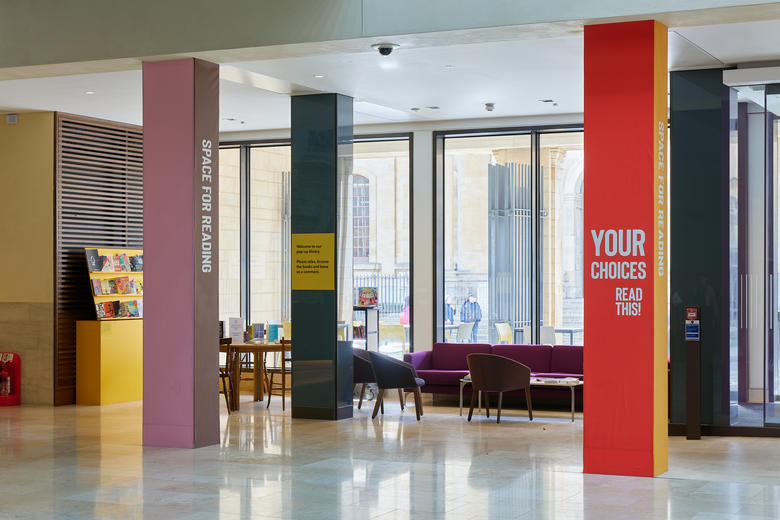MYROSLAVA HARTMOND

MYROSLAVA HARTMOND
The former Kyiv gallerist has returned to the UK and speaks about art, illness, diplomacy and war
Published: 8 January 2025
Author: Richard Lofthouse
Share this article

Myroslava Hartmond, Myro, (St Antony’s, 2012) is hard to capture because she dazzles in so many directions. The former art gallery director, suffering a serious health crisis in 2024, had a ‘moment of clarity’ and is currently selling her entire art collection, 155 works collected over two decades, under the title Farewell to Arms, raising money in the process for the International Red Cross to support Ukraine (details below).
But that’s just the start of a remarkable backstory with a great deal of Oxford in the mix.
The native of Ukraine is also a native of Great Britain, at least from the age of five when she came to Oxford from Ukraine with her economist father Andrij Halushka (Worcester, 1993).
Her sister Kateryna Marina (St Antony’s, 2018) is currently finishing a DPhil, also in international relations, and led the first spontaneous protest against the Russian invasion of Ukraine, in Radcliffe Square on February 24, 2022, then as the President of the Oxford University Ukrainian Society.
On that fateful day Myro, meanwhile, was trapped in a building in Kyiv with her mother, listening to blaring air raid sirens as the full-scale Russian invasion of Ukraine commenced in the early hours and great fear gripped the city.
A few days later she managed to address the Indian people through an eloquent Open Letter published in the Madras Courier. In it, she noted how ‘I always feel more British when I am in Ukraine, but emphatically Ukrainian in the UK.’

But if you break that polarity down, it fragments into further polarities – Oxford and London, art and politics, politics and diplomacy, diplomacy and fund raising. Of course, art and politics blend, especially in an authoritarian regime.
Myro wrote up her Oxford MPhil on art exhibitions as an instrument of Soviet propaganda during the Cold War, just as the EuroMaidan protests erupted on the streets of Kyiv in early 2014, prompting her return to Kyiv for the next eight years.
She reminds me that her GCSEs had also coincided with the Orange Revolution, that earlier expression of self-determination by ordinary Ukrainians in 2004-5. In fact it’s an open question, whether you could be an engaged Ukrainian and not take international relations seriously, given the history of the past quarter century, culminating in Ukraine’s ongoing, deadly struggle for the right to exist.
Myro’s other enduring love is art. She returned to Kyiv in 2014 to run Triptych: Global Arts Workshop, both a commercial art gallery and a cultural centre and well known in Kyiv as the first truly post-Soviet art hub, having first opened in 1988.
She made a big success of it until COVID destroyed tourism, the final nail in the coffin arriving at the behest of Putin two years hence.
Some weeks into the invasion, as Kyiv recovered from its gravest peril, Myro was able to get herself and her mother back to Oxford where she was appointed Programme Coordinator for ‘Refugee Academic Futures’ in the Oxford Department of International Development (ODID), all tied in with Oxford attaining official status as a University of Sanctuary in May of 2022 – a broad programme of support for refugees both in the wider community and among students and scholars.
‘It was serendipity. There I was at the same moment when the University was attaining Sanctuary status, led by Prof. Alexander Betts; and I also worked with Reuben College President Lionel Tarassenko, Lord Tarassenko, to help establish the Oxford University Graduate Scholarships for Ukraine Programme.’

Then in 2024 a huge opportunity presented itself to the former gallerist, and suddenly Myro found herself researching and curating 'Land, Sea, and Sky: Paul Nash in Oxford', an exhibition held at the Pembroke College JCR Art Gallery at 5 Brewer Street in May-June, tied into the Oxford Festival of the Arts.
‘Nash has not had the attention he merits. Furthermore, he lived in Oxford at different times, and some of his most famous work depicted scenes in or near Oxford. Those two things were drawn together in the exhibition.’
One of the less famous but striking images is Worcester College's painting by Nash, Oxford During the War which by coincidence adorns Ashley Jackson's recent book Oxford's War 1939-45.

Just as the exhibition was coming together, calamity struck in the form of a grave health scare, so much so that work on the project in the crucial final months was left to the rest of the curatorial team, but Myro was luckily well enough to attend the opening in early May and present the closing event with Will Gompertz. She speaks of needing to ration her energies so severely that life was winnowed down to its sparest forms – not unlike the experience of being trapped in Kyiv two years earlier.
‘I had a moment of clarity. Life needed to simplify. I decided to sell my art collection, all of it, in order the bring the works out of storage [by then in Oxford, following a gruelling export process from Kyiv] and into life, where hopefully they could be more widely enjoyed and appreciated.’
We turn to discussing Myro’s art collection, but not before a mini-digression concerning the landmark exhibition of Ukrainian art held at the Royal Academy in 2024, In the Eye of the Storm: Modernism in Ukraine, 1900–1930s.
‘I attended this with friends and family. It was very emotional for me. I knew some of these works of art very well, going right back to my undergraduate years in Kyiv, and even earlier. But let’s be honest about it. They would never have been displayed at the Royal Academy but for the Russian invasion.

…the works on display spanned pre-Soviet and Soviet periods, they were well chosen and well hung, and there was an emphatic truth running through the fact of the exhibition: because Russian began to destroy Ukraine with missiles in real time, at that point it finally became clear to everyone that Ukraine was not Russia. Before the invasion it was impossible to tell the world that Ukraine wasn’t also Russia. No one understood and no one was listening.’
Amidst the extensive catalogue of works Myro is currently selling, there are works of art that span the late and post-Soviet period, and could almost be understood as a chronological counterbalance for the pre- and early Soviet period featured in the Royal Academy exhibition.
The collection spans mostly oil painting and other graphic or mixed media forms, plus photography and some remarkable ceramics including Olexiy Apollonov’s 'Apollo, God of the Sun', that captures a hieratic, elemental head hearkening back to some of the most experimental early twentieth century forays into direct carving by the likes of Henri Gaudier-Brzeska (shown, top right).
The paintings begin with harmonies of shape and pattern by artists such as Vasyl Mizler, Viacheslav Malyna, and Natalia Korf-Ivanyuk; formalism by Maksym Dietkovskyi and the depiction by others of historical events such as the EuroMaidan.

Then there are spell-binding colourist landscapes by Avropegian Varoujian ('Mountain Road' by Varoujian, shown above left) and Volodymyr Chernikov; other themes rooted in regional and folk traditions, moving to older artists who were constrained by Soviet-era academic requirements yet appear to have realised a brilliantly oblique introspective expression through Romantic landscape painting echoing the early 1800s, such as Anatoliy Zhezher’s ‘Echo of the Skies’ (shown left) and O.V. Bazhan’s ‘Forest of October'. Myro’s collection then migrates towards still life, and contemporary photography that includes mordant recognition of Jewish persecution and murder during both Nazi and Soviet eras in Ukraine.
There is a playfully daubed acrylic white horse on black card called ‘White Horse Bus Stop Oxford,’ but the local reference is an exception rather than a theme – this is essentially an exuberant and eclectic Ukrainian collection that points in all directions, and in early 2025 represents an extraordinary one-off encounter for British art collectors who likely never before had the access to Ukrainian art or the traditions it represents.
Myro is now looking at new opportunities in the art, cultural diplomacy and fund-raising space, but one feels that art will continue to be central – she speaks warmly of recently taking Dr Jan Cox’s Continuing Education course on Scandinavian art which featured a much-needed recontextualization of Ukrainian-born ‘Russian realist’ Ilya Repin.
But for now she is disposing of her collection and it’s a not inconsiderable workload to manage the process.
FAREWELL TO ARMS. Myro explains: 'It is a celebration of my fifteen-year career as an arts professional: curator, gallerist, art advisor. In light of my changing circumstances, I am looking for new homes for 155 artworks, which I have collected over the past two decades. During this time, I discovered that art, especially original art, is a great source of energy. It inspires, uplifts, improves any room, and is never the same – it responds to your mood like a living thing.'
Browse the catalogue by following the link: https://www.farewell-to-arms.com/
A part of the proceeds will be donated to the ICRC (International Committee of the Red Cross).
OXFORD AS A COMMUNITY OF SANCTUARY:
https://www.ox.ac.uk/about/organisation/oxford-community-sanctuary
OXFORD CONTINUING EDUCATION PROGRAMME: Myro notes that Dr Jan Cox's latest course features pioneer Ukrainian painter and diarist Marie Bashkirtseff who in her short lifespan became one of the first women to exhibit at the Paris Salons.
IMAGE CREDITS: List and lead images by University of Oxford/Richard Lofthouse; Main images, credit Myroslava Hartmond; Image of Nash paintings hanging in situ, credit Christopher Baines. Book Jacket for 'Oxford's War', Bodleian Library Publishing/Ashley Jackson and Worcester College Oxford.















